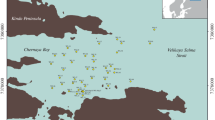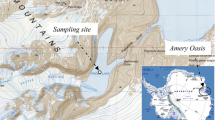Abstract
Seven sediment samples have been examined, taken from different depths of the deep-sea in the range of 1159m to 6482m. A total of 75 different 16S rDNA sequences (149 clones) analyzed clustered into the Proteobacteria, Gram-positive bacteria, Cytophaga, Planctomyces, and Actinomycetes and many sequences were from microorganisms that showed no phylogenetic affiliation with known bacteria. Clones identical to 16S rDNA sequences of members of the genus Pseudomonas were observed in all of the sediments examined. The second group of common sequences cloned from six sediment samples was related to the 16S rDNA sequence of a chemoautotrophic bacterium, the Solemya velum symbiont. Five 16S rDNA sequences from three sediments were related to those of the Alvinella pompejana epibiont which is a member of the ε-Proteobacteria. Only one sequence was obtained that was closely related to the 16S rDNA of the barophilic bacterium, Shewanella benthica, which might be a minor population in the deeper sediments. δ-Proteobacteria-related sequences were cloned from sediments obtained from sites near man-made garbage deposits and a Calyptogena community. These environments obviously would be richer in nutrients than other sites, and might be expected to show more types of bacteria than other deep-sea sediments. A large number of cloned sequences in this study showed very low identity to known sequences. These sequences may represent communities of as-yet-uncultivated microorganisms in the sediments.
Similar content being viewed by others
References
Alfredsson GA, Kristjansson JK, Hjorleifsdottir S and Stetter KO (1988) Rhodothermus marinus, gen. nov., sp. nov., a thermophilic, halophilic bacterium from submarine hot springs in Iceland. Journal of General Microbiology 134: 299–306
Andresson OS and Fridjonson OH (1994) The sequence of the single 16S rRNA gene of the thermophilic eubacterium Rhodothermus marinus reveals a distant relationship to the group containing Flexibacter, Bacterioides, and Cytophaga species. Journal of Bacteriology 176: 6165–69
Aznar R, Ludwig W, Amann RI and Schleifer KH (1994) Sequence determination of rRNA genes of pathogenic Vibrio species and whole-cell identification of Vibrio vulnificus with rRNA-targeted oligonucleotide probes. International Journal of Systematic Bacteriology 44: 330–337
Bowman JP, Cavanagh J, Austin JJ and Sanderson K (1996) Novel Psychrobacter species from antarctic ornithogenic soils. International Journal of Systematic Bacteriology 46: 841–848
Cavanaugh CM (1983) Symbiotic chemoautotrophic bacteria in marine invertebrates from sulfide-rich habitats. Nature 302: 58–61
Cavanaugh CM (1985) Symbiosis of chemoautotrophic bacteria and marine invertebrates from hydrothermal vents and reducing sediments. Bulletin of Biological Society (Washington) 6: 373–388
Colquhoun JA, Heald SC, Li L, Tamaoka J, Kato C, Horikoshi K and Bull AT (1998) Taxonomy and biotransformation activities of some deep-sea actinomycetes. Extremophiles 2: 269–277
DePaola A, Capers GM and Alexander D (1994) Densities of Vibrio vulnificus in the intestines of fish from the US Gulf coast. Applied Environmental Microbiology 60: 984–988
Ehrich S, Behrens D, Lebedeva E, Ludwig W and Bock E (1995) A new obligately chemolitho-autotrophic, nitrite-oxidizing bacterium, Nitrospira moscoviensis sp. nov. and its phylogenetic relationship. Archives of Microbiology 164: 16–23
Eisen JA, Smith SW and Cavanaugh CM (1992) Phylogenetic relationships of chemoautotrophic bacterial symbionts of Solemya velum say (Mollusca: Bivalvia) determined by 16S rRNA gene sequence analysis. Journal of Bacteriology 174: 3416–3421
Felbeck H (1981) Chemoautotrophic potential of the hydrothermal vent tube worm, Riftia pachyptila Jones (Vestimentifera). Science 213: 336–338
Fisher C (1990) Chemoautotrophic and methanotrophic symbioses in marine invertebrates. Reviews in Aquatic Sciences 2: 399–436
Fogg GE (1986) Picoplankton. Proceedings of the Royal Society of London Series B 228: 1–30
Haddad A, Camacho F, Durand P and Cary SC (1995) Phylogenetic characterization of the epibiotic bacteria associated with the hydrothermal vent polychaete Alvinella pompejana. Applied Environmental Microbiology 61: 1679–1687
Herrick JB, Madsen EL, Batt CA and Ghiorse WC (1993) Polymerase chain reaction amplification of naphthalene-catabolic and 16S rRNA gene sequences from indigenous sediment bacteria. Applied Environmental Microbiology 59: 687–694
Hiraishi A, Furuhata K, Matsumoto A, Koike KA, Fukuyama M and Tabuchi K (1995) Phenotypic and genetic diversity of chlorine-resistant Methylobacterium strains isolated from various environments. Applied Environmental Microbiology 61: 2099–2107
Jannasch HW and Taylor CD (1984) Deep-sea microbiology. Annual Review of Microbiology 38: 487–514
Janssen PH, Schuhmann A, Bak F and Liesack W (1996) Disproportionation of inorganic sulfur compounds by the sulfate-reducing bacterium Desulfocapsa thiozymogenes gen. nov., sp. nov. Archives of Microbiology 166: 184–192
Kato C, Sato T and Horikoshi K (1995) Isolation and properties of barophilic and barotolerant bacteria from deep-sea mud samples. Biodiversity and Conservation 4: 1–9
Kato C, Masui N and Horikoshi K(1996) Properties of obligately barophilic bacteria isolated from a sample of deep-sea sediment from the Izu-Bonin trench. Journal of Marine Biotechnology 4: 96–99
Kato C, Li L, Tamaoka J and Horikoshi K (1997) Molecular analyses of the sediment of the 11000-m deep Mariana Trench. Extremophiles 1: 117–123
Kato C, Inoue A and Horikoshi K (1998a) Characteristics of deep-sea microorganisms adapted to an extreme environment. In: Fingerman M, Nagabhushanam R and Thompson MF (eds) Marine Biotechnology Vol. 2: Environmental Marine Biotechnology, pp 33–61. Oxford and IBH Publishing Co, New Delhi
Kato C, Li L, Nakamura Y, Nogi Y, Tamaoka J and Horikoshi K (1998b) Extremely barophilic bacteria isolated from the Mariana Trench, challenger deep, at a depth of 11 000 meters. Applied Environmental Microbiology 64: 1510–1513
Lee JV, Gibson DM and Shewan JM (1977) A numerical taxonomic study of some Pseudomonas-like marine bacteria. Journal of General Microbiology 98: 439–451
Li L, Kato C, Nogi Y and Horikoshi K (1998) Distribution of the pressure-regulated operons in deep-sea bacteria. FEMS Microbiology Letters 159: 159–166
Morita RY (1976) Survival of bacteria in cold and moderate hydrostatic pressure environments with special reference to psychrophilic and barophilic bacteria. In: Gray TRG and Postgate JR (eds) The Survival of Vegetative Microbes, pp 279–298. Cambridge University Press, Cambridge
Nunes OC, Donato MM and Da Costa MS (1992) Isolation and characterization of Rhodothermus strains from S. Miguel, Azores. Systematic and Applied Microbiology 15: 92–97
Reysenbach AL, Giver LJ, Wickham GS and Pace NR (1992) Differential amplification of rDNA genes by polymerase chain reaction. Applied Environmental Microbiology 58: 3417–3418
Saitou N and Nei M (1987) The neighbor-joining method: a new method for reconstructing phylogenetic trees. Molecular Biology and Evolution 4: 406–425
Tamegai H, Li L, Masui N and Kato C (1997) A denitrifying bacterium from the deep sea at 11000-m depth. Extremophiles 1: 207–211
Tanoue E, Nishiyama S, Kamo M and Tsugita A (1995) Bacterial membranes: Possible source of a major dissolved protein in seawater. Geochimica et Cosmochimica Acta 59: 2643–2648.
Author information
Authors and Affiliations
Rights and permissions
About this article
Cite this article
Li, L., Kato, C. & Horikoshi, K. Bacterial diversity in deep-sea sediments from different depths. Biodiversity and Conservation 8, 659–677 (1999). https://doi.org/10.1023/A:1008848203739
Issue Date:
DOI: https://doi.org/10.1023/A:1008848203739




